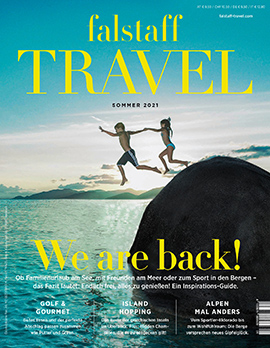
Jean-Michel Gathy: How He Changed the Hotel Industry With his Designs
Belgian architect Jean-Michel Gathy designs some of the world’s finest hotels. A true visionary, he blends design with emotion, seamlessly combining interior decor and landscape architecture. He credits his success to his humility, stating, “I am not a prima donna.”
January 7, 2025
His life’s work can be summed up as a tautly stretched hammock over the sea. While it may sound trivial, it revolutionized an entire industry. When the One&Only Reethi Rah opened in the North Malé Atoll in 2005, Belgian architect Jean-Michel Gathy came up with something truly unique for the overwater villas: he equipped each terrace with a net suspended above the Indian Ocean, where guests could lounge. As inconsequential as it may seem, the impact was monumental. Today, it’s hard to find a resort in the Maldives—or any similar idyllic seaside destination—that doesn’t feature a relaxation net over the water.
Éric Martin
Jean-Michel Gathy is the doyen of luxury hospitality, a creator of both intricate details and grand concepts. The iconic swimming pool atop the three towers of Singapore’s Marina Bay Sands—a breathtaking "bathtub of extremes"—is one of his designs. For over 30 years, his company, Denniston, has been crafting high-end hotels for brands that are destinations in their own right: Aman, Cheval Blanc, The Chedi. He refers to himself as the spoiled child of the industry, as his Kuala Lumpur office receives at least two or three new project inquiries daily—most of which they decline.
© provided
Jean-Michel Gathy’s big break came in 1988. At the time, the young architect was working in Hong Kong, designing branches for major banks and retail spaces for fashion conglomerates, when he met real estate developer Adrian Zecha. Zecha had recently founded the Aman hotel brand and commissioned Gathy to design a resort on Indonesia’s Moyo Island. Gathy envisioned a camp of spacious safari tents, set along a tree-lined beach with stunning views of the Flores Sea. This project marked the beginning of his illustrious career in luxury hospitality design.
© Rupert Peace
Zecha was captivated by the synthesis of natural spectacle and understated luxury, and from that point on, he worked almost exclusively with the Brussels-born architect. To date, Gathy has designed more than ten hotels for the group, including the first property of Aman’s sister brand Janu in Tokyo and the spectacular Aman New York. The latter opened in 2022 after a five-year renovation of a 1920s skyscraper, located directly across from the far more ostentatious Trump Tower.
© provided
The so-called Crown Building showcases many hallmarks of Gathy’s work: indirect lighting, classic geometry, and a preference for spa-like bathrooms. He banished the noise of bustling 5th Avenue with modern soundproofing, leaving guests to experience the city's hustle and bustle only on the restaurant terrace. In the rooms, fireplaces evoke the charm of a countryside retreat, while sliding doors create adaptable living spaces.
Jean-Michel Gathy embraces a holistic approach to design. As one of the few architects globally who simultaneously considers exterior aesthetics, interior design, and landscaping, he is deeply involved in every detail. In the weeks leading up to the New York opening, the self-proclaimed control freak was seen spending 18-hour days at the hotel, personally rearranging furniture and lifting potted plants onto balconies until he was satisfied with the result. "I thrive on this adrenaline," Gathy said in an interview. "It fuels my creativity."
© provided
What sets Gathy apart from other luminaries in his field is his aversion to monumentalism. "I am not a prima donna," he famously declares. He avoids prestige projects like libraries, bridges, or office towers that impress solely with their façades. Instead, Gathy seeks emotional architecture—spaces where people feel at ease, even if they can't pinpoint why. He designs experiences, not objects, blending intimacy with drama and prioritizing comfort over grandeur. His creative process always begins by hand. To this day, he sketches his initial ideas on paper using a felt-tip pen from the Japanese brand Artline, black ink, 0.4 thickness. For Gathy, these ideas flow from the heart through the hand, and the act of transferring them to white paper is where the creative process unfolds. Why doesn’t he use a computer? "Because I don’t know how," he once admitted.
© Clinique La Prairie
In his work, Gathy blends Asian design elements with European historical influences. He values the nuanced approach of his adopted home in Asia and the structured mindset of the West. The result is a unique mix that oscillates between these two worlds—like in Portonovi, the harbor district on Montenegro's Bay of Kotor, created by Azerbaijani developers. The accompanying luxury hotel, operated by the One&Only group, was designed by Jean-Michel Gathy and opened in May 2021, between two lockdowns. This five-star hotel boasts undeniable perks: automatically rising toilet seats, fireplaces that ignite with the push of a button, and curtains that gently open when you press a switch by the bed. The property features a main building with three residential towers, several villas, a sprawling park, a man-made sandy beach, and a state-of-the-art medical spa. During breakfast, guests can enjoy views of palm trees, deep blue waters, and the lush green hills across the bay.
© Rupert Peace
It’s a quintessential Gathy building—you immediately feel well cared for, yet curiously untethered to any specific location. Mexico, Maldives, Montenegro? Only subtle details hint at the local connection—perhaps unique carpets, architectural references, or distinctive artisanal traditions. Anticipation is high for how Gathy has designed the Aman Nai Lert, set to open later this year in Bangkok. One thing about the skyscraper is certain, though: it won’t feature hammocks on the facade.
Reading tip: Why we love urban resorts

This article appeared in the Falstaff TRAVEL issue Fall 2024.








